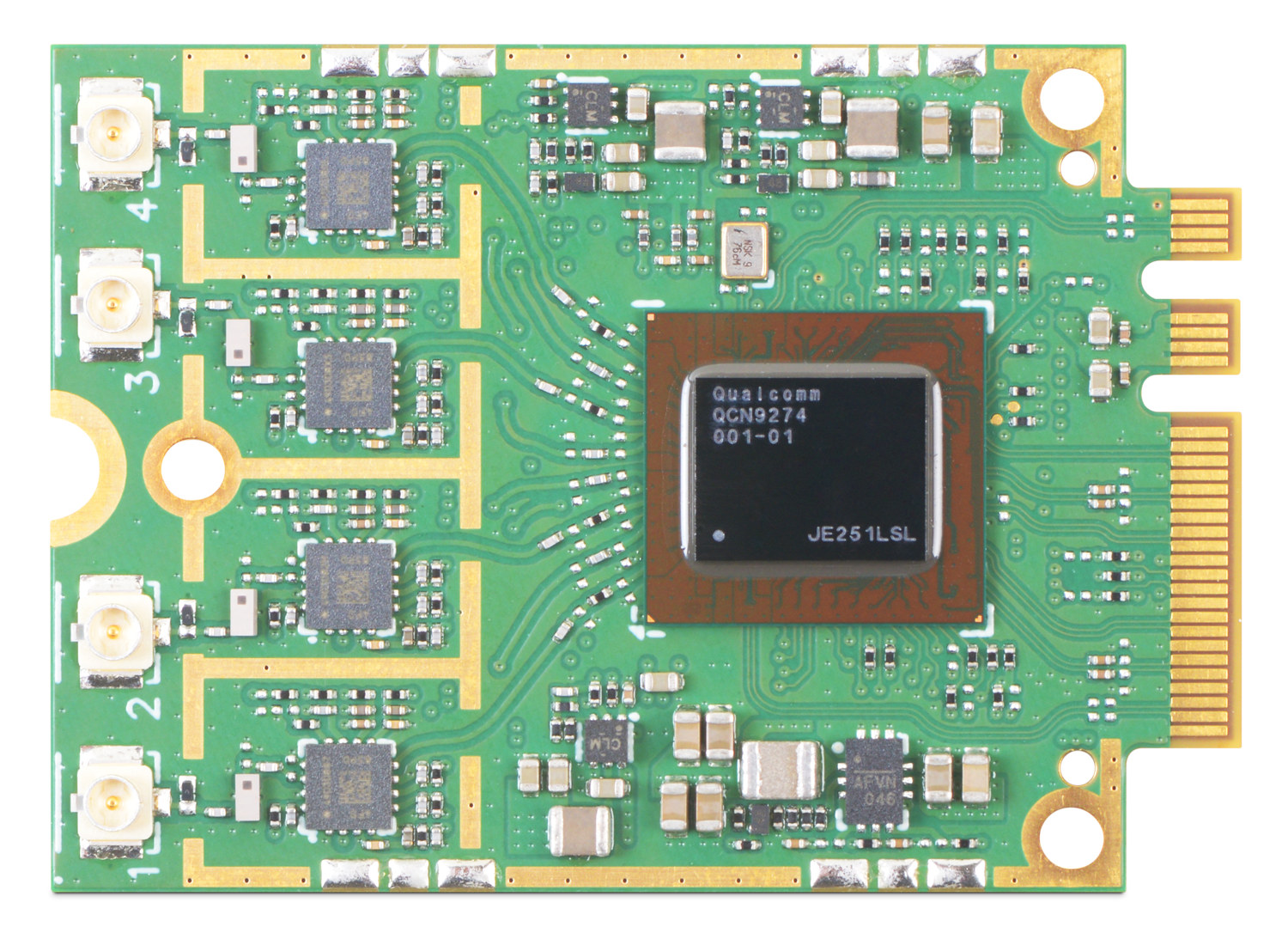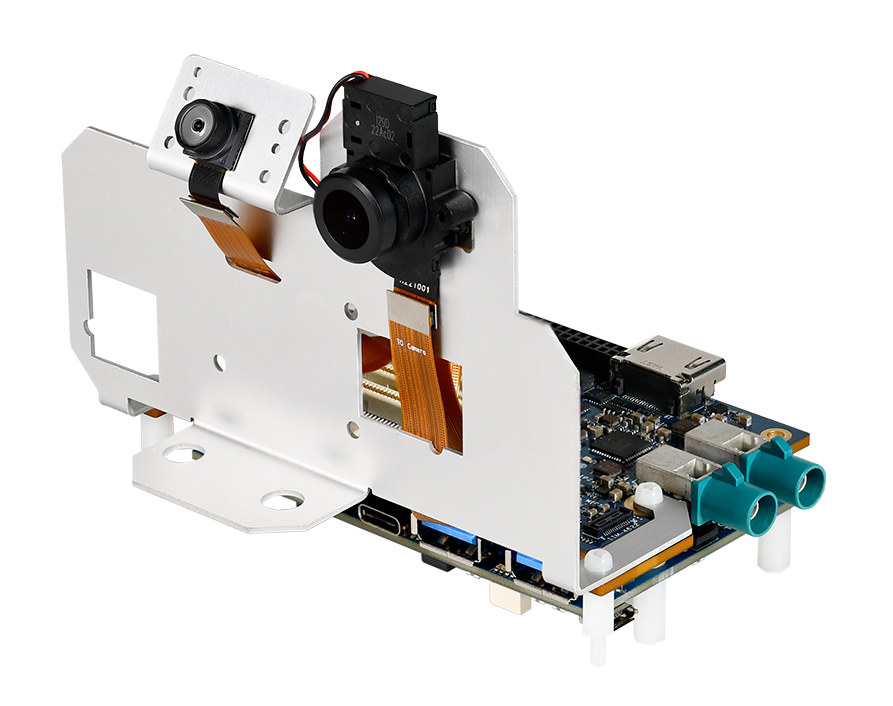8devices has recently introduced TobuFi, a Qualcomm QCS405-powered System-on-Module (SoM) featuring dual-band Wi-Fi 6 and Wi-Fi 5 capabilities. The device also features 1GB LPDDR3, 8GB of eMMC storage, and multiple display resolutions. It also offers various interfaces, including USB 3.0, HDMI, I2S, DMIC, SDC, UART, SPI, I2C, and GPIO. In previous posts, we covered 8devices product launches like the Noni M.2 WiFi 7 module, Rambutan and Rambutan-I modules, Habanero IPQ4019 SoM, Mango-DVK OpenWrt Devkit, and many more innovative products. If you’re interested in 8devices, feel free to check those out for more details. 8devices TobuFi SoM specifications: SoC – Qualcomm QCS405 CPU – Quad-core Arm Cortex-A53 at 1.4GHz; 64-bit GPU – Qualcomm Adreno 306 GPU at 600MHz; supports 64-bit addressing DSP – Qualcomm Hexagon QDSP6 v66 with Low Power Island and Voice accelerators Memory – 1GB LPDDR3 + 8GB eMMC Storage 8GB eMMC flash SD card – One 8-bit (SDC1, 1.8V) and one […]
8Devices Noni M.2 WiFi 7 module supports FirmUx embedded Linux distribution
8Devices Noni is a family of M.2 A+E-Key WiFi 7 modules built on the QCN9274/QCN6274 chipsets, delivering up to 11 Gbps link rate in 4×4 MIMO or split 2×2 + 2×2 configurations, and supporting FirmUX embedded Linux OS. The Noni modules support Multi-Link Operation (MLO) for simultaneous communication on different frequencies and adaptive interference puncturing in order to maintain performance in various environments and the QCN9274-based variants also support advanced features such as Provisioned Multi-Link, Dense deployment, and Location and RF sensing. 8devices Noni specifications: All the Noni modules support a 2-lane PCIe Gen 3 interface connection to the host device. 8devices Noni modules support the FirmUX embedded Linux platform that provides developers a choice between fully open-source or proprietary Qualcomm drivers. The OS enables WPA3 security, comes with a responsive UI dashboard, supports Wireguard VPN, and the company claims up to 34 percent improvement over OpenWrt on the earlier […]
Review of Arylic BP50 Bluetooth 5.2 preamplifier with TIDAL Music
Arylic has sent us a sample of their low-cost BP50 Bluetooth 5.2 preamplifier for review. It features an ESS Saber ES9023P DAC chip and Qualcomm QCC3040 Bluetooth chip with support for aptX, aptX HD (High Definition), aptX LL (Low Latency), and aptX AD (Adaptive). It offers many input-output connections such as phono preamp MM/MC, optical, Line-in, subwoofer output, and HDMI ARC. You can find the full details about the specifications in the aforelinked announcement. Arylic BP50 unboxing Let’s start our review with an unboxing. Our package came with the following items: Arylic BP50 Bluetooth 5.2 preamplifier A 12V/1A power supply 2x Bluetooth antennas (3dBi) A remote Control A user manual As a reminder, here are the ports on the back of the preamplifier as shown in a stock image from the company. Test setup For this review, we’ve connected the Arylic BP50 Bluetooth preamplifier’s Line-Out port to the CD Audio […]
Qualcomm S3 Gen 2 Sound Platform supports LE Audio and Auracast broadcast audio
The Qualcomm S3 Gen 2 Sound Platform (QCC5181) is a Bluetooth 5.4 audio solution designed for dongles and adapters with ultra-low latency (<20 ms) and support for the latest LE Audio and Auracast broadcast audio standards. The platform was introduced last year, but the company says it has now launched a “newly enhanced solution” optimized for gaming that “combines Snapdragon Sound and LE Audio to deliver ultra-low latency of less than 20ms for lag-free wireless audio with voice back-channel for in-game chat”. The new solution also focuses on USB dongles and adapters since few hosts support Bluetooth 5.4 at this time. Qualcomm S3 Gen 2 (QCC5181) Sound Platform specifications: CPU – Dual-core 32-bit microcontroller clocked at up to 80 MHz DSP – Qualcomm Kalimba DSP @ 240 MHz with 384 kB program RAM, 1,024kB data RAM Storage – External QSPI flash Connectivity Bluetooth 5.4 qualified Bluetooth Low Energy, Bluetooth Classic, […]
Arylic H50 wireless stereo amplifier supports Airplay2, Amazon Alexa (Sponsored)
Arylic H50 is a new wireless stereo amplifier with an ESS9023p Sabre DAC and support for Airplay2, Amazon Alexa, and services such as Spotify Connect and Tidal Connect. It offers dual-band WiFi 4 connectivity, and Bluetooth 5.2 audio support through a Qualcomm QCC3040 SoC with aptX HD, supports 50W stereo speakers, and plenty of audio input sources from analog and digital audio ports to HDMI ARC, as well as NAS (DLNA) function and USB mass storage. Arylic H50 specifications: SoC – Qualcomm QCC3040 with 32-bit application processor @ 32 MHz, 32-bit system processor @ 32 MHz, Kalimba DSP @ 120 MHz, Bluetooth 5.2 and aptX HD support. DAC – ESS9023p Sabre DAC Display – 2.23-inch OLED display panel Connectivity 10/100M RJ45 port Dual-band (2.4GHz/5.0GHz) WiFi 4 (802.11 b/g/n) Bluetooth 5.2 with up to 15m range, suppport for aptX-HD, aptX-LL, aptX-AD, SBC, AAC Streaming Protocols – Works with Alexa, Spotify Connect, […]
Linux 6.3 release – Notable changes, Arm, RISC-V and MIPS architectures
Linux Torvalds has just announced the release of Linux 6.3 on the Linux Kernel Mailing List (LKML): It’s been a calm release this time around, and the last week was really no different. So here we are, right on schedule, with the 6.3 release out and ready for your enjoyment. That doesn’t mean that something nasty couldn’t have been lurking all these weeks, of course, but let’s just take things at face value and hope it all means that everything is fine, and it really was a nice controlled release cycle. It happens. This also obviously means the merge window for 6.4 will open tomorrow. I already have two dozen pull requests waiting for me to start doing my pulls, and I appreciate it. I expect I’ll have even more when I wake up tomorrow. But in the meantime, let’s enjoy (and test) the 6.3 release. As always, the shortlog […]
Qualcomm Robotics RB1 and RB2 development kits launched for $199 and up
We quickly mentioned the Qualcomm Robotics RB1 and RB2 development kits in our post about Lantronix Open-Q 2210RB and 4210RB SiPs mostly to complain about the lack of information at the time. But things have changed the Qualcomm Robotics RB1 and RB2 devkits for cheaper, smaller Linux-powered robots with lower power consumption are now available, and we have more details with three options: Core Kit, Vision Kit, and Full Kit. So let’s have a closer look. All kits are based on the Qualcomm Robotics RB1/RB2 Core Kit with the following (preliminary) specifications: System-on-module RB1 – Thundercomm TurboX C2210 SoC – Qualcomm QRB2210 CPU – Quad-core Cortex-A53 processor at up to 2.0 GHz GPU – Adreno 702 GPU at 845 MHz with support for OpenGL ES 3.1, Vulkan 1.1, OpenCL 2.0 Hexagon QDSP6 v66 DSP 1080p 30 fps encode / 1080p 30fps decode System Memory – 1GB or 2GB LPDDR4 Storage […]
Lantronix Open-Q 2210RB and 4210RB SiPs for robotics power RB1/RB2 development kit
What comes after Qualcomm Robotics RB3, RB5, and RB6 platforms? Apparently, it’s Qualcomm Robotics RB1 and RB2 platforms powered by Qualcomm QRB2210 and Qualcomm QRB4210 processors respectively and optimized for cheaper, smaller robots with lower power consumption. But Qualcomm is one of the lamest companies known to man, so they did not include any photos when announcing the Robotics RB1 and RB2 platforms, so I’ll focus this post on Lantronix Open-Q 2210RB and 4210RB system-in-packages (SiP) based on the same processors, as well as the Open-Q RB1/RB2 development kit. Open-Q 2210RB and 4210RB SiP The new system-in-packages are very similar to the earlier Open-Q 2290CS and 4290CS SIPs for industrial IoT and machine vision applications, with the only difference being the Qualcomm processor used, so I invite you to read the earlier post for the full details, and I’ll just provide summaries here. Open-Q 2210RB key features: SoC – Qualcomm […]










